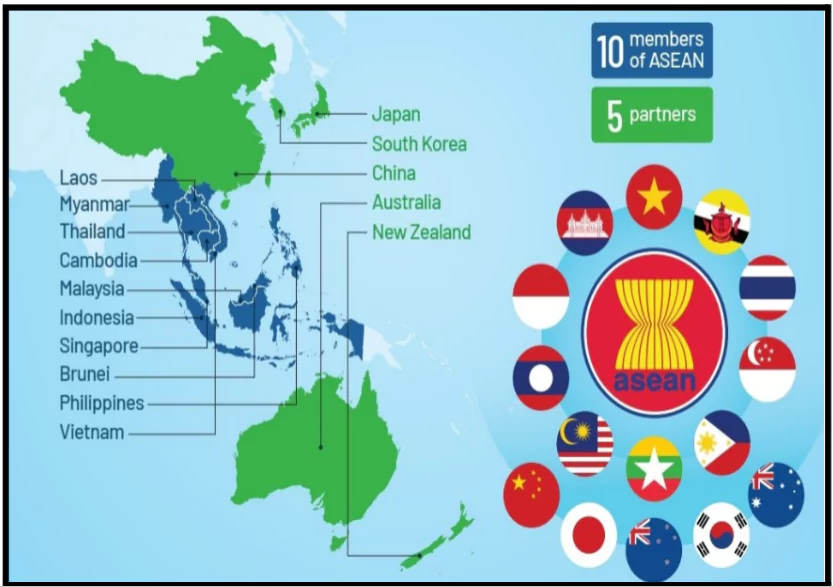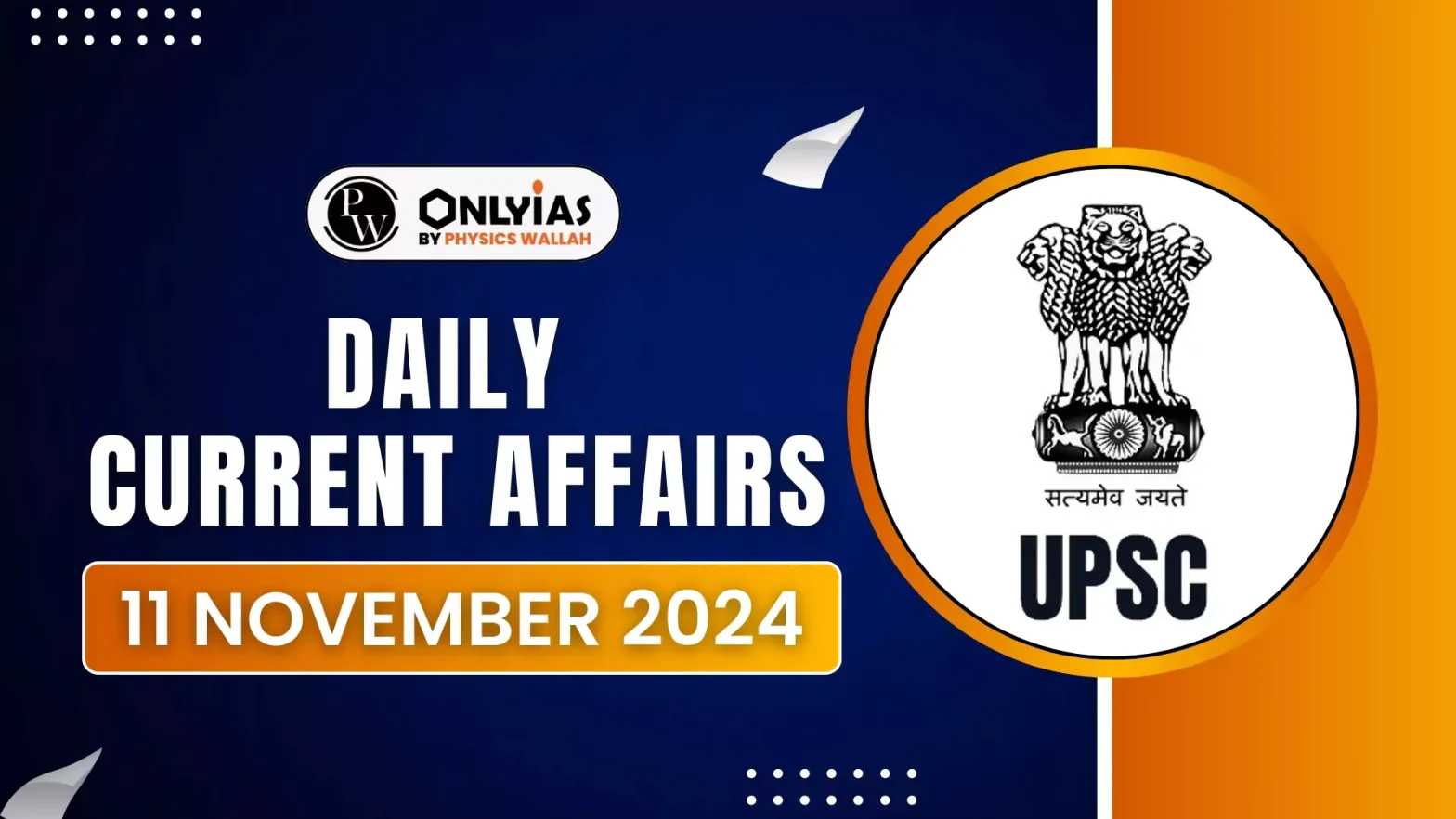Recently, the CEO of NITI Aayog pointed out that India should reconsider becoming a part of the Regional Comprehensive Economic Partnership (RCEP).
| The Comprehensive and Progressive Agreement for Trans-Pacific Partnership (CPTPP) is a free trade agreement (FTA) between Australia, Brunei Darussalam, Canada, Chile, Japan, Malaysia, Mexico, Peru, New Zealand, Singapore and Vietnam. |
India should be part of RCEP and CPTPP: NITI Aayog CEO
- Comprehensive and Progressive Agreement for Trans-Pacific Partnership (CPTPP): He also suggested that India should become a member of the Comprehensive and Progressive Agreement for Trans-Pacific Partnership (CPTPP).
- World Bank Urges India to Reevaluate Stance on RCEP: The World Bank’s recent ‘India Development Update’ has called on India to reconsider its position on the Regional Comprehensive Economic Partnership (RCEP).
- India and RCEP: India was a founding member of the RCEP.
- However, in 2019, India announced that it would not join the Regional Comprehensive Economic Partnership (RCEP)
- Fast-Track Joining Option: India has the advantage of joining the agreement without waiting for the typical 18-month waiting period required for new members under RCEP terms.
- Stance of RCEP Signatories: RCEP signatory states said they plan to commence negotiations with India once it submits a request of its intention to join the pact “in writing”, and it may participate in meetings as an observer prior to its accession.
Enroll now for UPSC Online Course
About Regional Comprehensive Economic Partnership (RCEP)

- Grouping: It is a mega-regional economic agreement between ASEAN and their FTA partners, aiming to boost trade and investment in the region.
- Members: RCEP is a 15-member grouping.
- ASEAN Nations: Brunei, Cambodia, Indonesia, Laos, Malaysia, Myanmar, the Philippines, Singapore, Thailand, and Vietnam.
- Five FTA partners: Australia, China, Japan, New Zealand, and South Korea.
- Timeline: RCEP negotiations began in 2012, leading to its official signing in November 2020.
- The agreement came into force on January 1, 2022.
- Coverage Areas: Trade in goods and services, investment, economic and technical cooperation, intellectual property, competition, dispute settlement, e-commerce, small and medium enterprises (SMEs) and other issues.
- Significance: It is the world’s largest free trade agreement by members’ GDP.
- It is estimated that through its trade liberalising provisions RCEP could lead to income gains of over $200 billion by 2030 and add $500 billion to world trade.
Reasons for India Withdrawing from RCEP
- Non-Tariff Barriers (NTBs): Indian companies faced non-tariff barriers, making it harder to compete in RCEP member markets.
| Non-tariff barriers refer to trade restrictions that do not involve tariffs or taxes on imports and exports but still act as obstacles to trade. Example: Embargoes, Import licensing, Subsidies, Quotas, Quantity Restrictions etc. |
- High Tariff Reductions: The RCEP required India to reduce tariffs on over 70% of goods from China, Australia, and New Zealand, and nearly 90% from Japan, South Korea, and ASEAN, potentially making imports cheaper and harming local businesses.
- Worsening Trade Deficit
- Trade Deficit with RCEP Countries: India had a trade deficit with 11 out of 16 RCEP countries in FY 2019.
- China as a Major Contributor: India’s trade deficit with China alone was $52 billion out of a total $105 billion deficit with RCEP countries.
- Unfavourable FTA Experience: India already has FTAs with 13 of the 15 RCEP members, including ASEAN, South Korea, and Japan.
- Between 2007-09 and 2020-22, the trade deficit with ASEAN grew by 302.9%, with South Korea by 164.1%, and with Japan by 138.2%.
- China Factor:
- China’s Economic Model: It is characterised by trade-distorting subsidies and extensive state control over production and labour, creating a competitive imbalance.
- While the RCEP advocates free and fair competition, China’s industrial policies and subsidy practices makes it difficult for economies like India to compete without equivalent support structures.
- Market Access : India was not assured of reciprocal market access in certain RCEP countries, particularly China.
- Lack of Auto Trigger Mechanism: India wants an auto-trigger mechanism to be institutionalised in the pact.
- This would serve as a kind of protective mechanism that a member country can invoke to safeguard in case of an unexpected flow of imports after RCEP comes into effect.
- But this was not included in RCEP terms.
- Ratchet Obligations: India wants exemptions built into the ratchet obligations as part of the pact.
- A ratchet obligation implies that a member country cannot raise tariffs once the pact comes into effect.
- An exemption would imply that a country will be able to impose restrictive measures later on grounds of protecting national interest.
- Issue of Data Localisation: India wants all countries to have the rights to protect data.
- This would imply that countries can share data only where it is “necessary to achieve a legitimate public policy objective” or “necessary in the country’s opinion, for the protection of its essential security interests or national interests”.
- Flexible Bilateral Trade Agreements: India already has functional Free Trade Agreements (FTAs) with several RCEP members, like Japan, South Korea, and Australia, which address its trade priorities more effectively than RCEP would.
- Limited Gains in Services and Digital Trade: RCEP is primarily goods-focused with limited provisions for services, missing key areas like IT, skilled labour mobility, and digital trade which are crucial for India’s exports.
- India advocated for greater labour and services movement in return for opening its market.
- Rules of origin (RoOs): India feared that lenient rules of origin would allow products to be routed through other countries, leading to dumping of goods in India and hurting domestic industries.
- Rules of origin are the criteria used to determine the national source of a product.
- Threat to Domestic Sectors
- Plantation and Rubber Products: Countries like Vietnam and Indonesia could undercut domestic rubber prices with cheaper exports.
- Dairy Sector Concerns: India’s small-scale dairy sector would struggle against efficient producers in New Zealand and Australia, who sought unrestricted access to India.
Check Out UPSC CSE Books From PW Store
Potential Benefits Of India Exiting RCEP
- Control Over Imports and Domestic Industry Protection: Exiting RCEP allows India to maintain regulatory control to limit the influx of cheap Chinese goods, which could otherwise harm domestic industries.
- Reduce Overdependence On China: By staying out of RCEP, India positioned itself to diversify its trade partners and reduce the risk of overdependence on China.
- Example: India’s decision to not join the RCEP was validated when the COVID-19 pandemic highlighted the vulnerabilities associated with an over-reliance on China-centric supply chains.
- Control Over Trade Deficits: India can maintain greater control over its trade balance.
- India already has a substantial trade deficit with China, exceeding $85 billion in FY2024.
- According to trade policy think tank Georgia Tech Research Institute (GTRI), RCEP member countries, such as Japan, South Korea, and ASEAN members, have seen their trade deficits with China increase since joining the bloc.
- Protection Against Dumping Practices: Non-participation in RCEP allows India to implement protective measures against dumping (selling goods at below-market prices) practices, particularly by China, ensuring that Indian industries are not undermined by unfair trade practices.
|
Advantages Of India Becoming A Member Of RCEP
- Enhanced Trade Opportunities: Joining RCEP would provide India access to larger markets in the Asia-Pacific region, boosting exports, especially from MSMEs, which account for 40% of India’s exports.
- Integration into Global Supply Chains: RCEP participation would help integrate India into global supply chains.
- Example: There are estimations that India could gain as much as $60 billion in income by 2030 if it joins RCEP.
- Improved Competitiveness: Engaging in RCEP would encourage reforms that boost India’s competitiveness, especially in sectors such as agriculture, technology, and services.
- Regulatory Alignment: Being part of RCEP would require aligning India’s regulatory frameworks with international standards, improving the business environment and attracting more foreign direct investment (FDI).
- Strategic Alignment with Neighbors: RCEP membership would improve India’s trade relations with Southeast Asian countries, supporting its Act East policy and deepening economic and diplomatic ties in the region.
- Long-term Economic Benefits: RCEP’s comprehensive approach to trade liberalisation could lead to sustained economic growth, reducing poverty and boosting income levels through greater participation in global value chains.
Potential Costs of India Not Joining RCEP
- Enhanced Economic Leverage for China: Without India, RCEP strengthens China’s economic influence in Asia-Pacific, allowing it to wield greater power in the region.
- China’s economic footprint could impact India’s neighbours, potentially shifting regional loyalties towards China due to increased economic dependence.
- SCRI: The Supply Chain Resilience Initiative (SCRI) is a formal agreement launched in 2021 between India, Japan, and Australia.
- Aim: The aim is to reduce dependence on a single country for sourcing by diversifying supply chains across multiple countries and regions.
- This can potentially de-risk an economy from sudden manmade and natural supply chain disruptions.
|
- Impact on Bilateral Trade with RCEP Members: India’s absence from RCEP may lead member nations to prioritise intra-bloc trade, potentially reducing India’s access to this vast market of over 2 billion people.
- Challenges to Indo-Pacific Collaboration: India’s decision could weaken the Australia-India-Japan partnership in the Indo-Pacific and hamper progress on initiatives like the Supply Chain Resilience Initiative (SCRI).
- Impact on India’s Manufacturing Ambitions: India’s vision to become a manufacturing hub is hindered by its exclusion from RCEP, limiting direct access to a key trade bloc.
- Setback to Act East Policy: RCEP’s absence impacts India’s Act East policy, reducing India’s economic presence in the region and making diplomatic and economic ties harder to strengthen.
Enroll now for UPSC Online Classes
Way Forward
- Tax Rationalisation: TheParliament committee has recommended the rationalisation of direct and indirect taxes in line with global standards to improve the competitiveness of Indian industries.
- This would help Indian industries perform better in international markets.
- Strengthening Domestic Industries: India must focus on making its domestic industries especially MSME’s more competitive and robust, enabling them to successfully compete in any international market.
- Negotiations with the European Union (EU): Expediting trade negotiations with the European Union is a priority, as the EU is India’s second-largest export destination.
- Comprehensive discussions are needed to be done on labour and environmental and investor protection standards.
- India should cash in on the ‘China plus one’ strategy: China Plus One, also known simply as Plus One or (C+1), is the business strategy to avoid only investing in China and spread business or channel investments into other developing countries such as India, Thailand, Turkey or Vietnam.
- Atmanirbhar Bharat: India’s Atma Nirbhar Bharat initiative aims to strengthen sectors like solar, domestic manufacturing, pharmaceuticals, digital trade, green technologies, electronics etc.
- This could boost manufacturing and enhance India’s global competitiveness, potentially leading India to reconsider joining RCEP.
Conclusion
While RCEP poses challenges, it is also a gateway to global markets and economic growth. India’s absence may cost it influence in regional trade policy and hinder its integration into global supply chains, underscoring the need to reconsider RCEP membership for long-term benefits.
![]() 11 Nov 2024
11 Nov 2024

